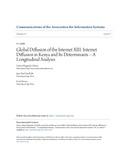| dc.description.abstract | This paper assesses Internet diffusion and its determinants in Kenya using the Global Diffusion of the Internet (GDI)
framework. Kenya was selected due to its strategic importance for the economic progress of the great lakes region
of Africa. An understanding of Internet diffusion in Kenya provides preliminary insight into how the process might
unfold in Eastern Africa.
The analysis shows that in 2008, less than 10 percent of the population accessed the Internet, with a majority of
users clustered around two major urban centers. There is an indication that across the sectors of education,
commerce, health, and public service, the Internet is being embraced, with potential for further diffusion. The
underlying national Internet connectivity infrastructure is well established, but skewed in favor of urban centers that
have high levels of electricity penetration. Vibrant competition exists between Internet service providers despite a
persistent monopoly in national fixed line telecommunications provision. A few sophisticated applications of the
Internet were found in several sectors.
A snap shot of the state of Internet diffusion in Kenya reflects, on average, good performance on the various
dimensions of the GDI framework. However, this overall picture masks the reality that the majority of the population,
mostly in rural areas, lack access to basic amenities such as electricity, and hence infrastructure to support the
Internet. The trajectory along which the Internet is diffusing has therefore led to the exclusion of this majority. The
critical role that governments in developing countries play needs to be brought to the fore in order to ensure that the
Internet diffusion trajectory is not left entirely to the commercial sector. The government’s ability to marshal
resources, execute telecommunications regulation, as well as enable change remains pivotal to ensuring inclusive
Internet diffusion. | en_US |

